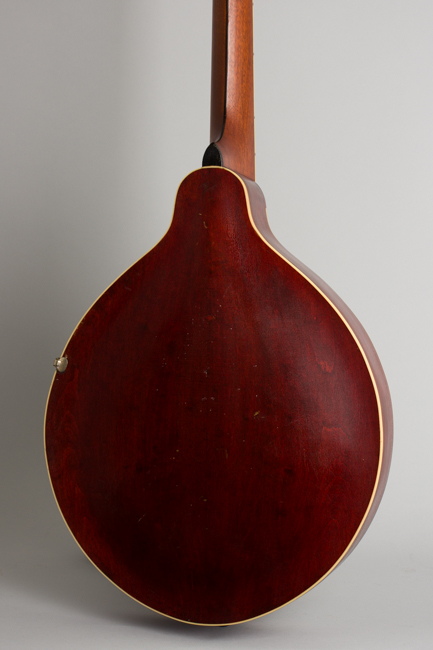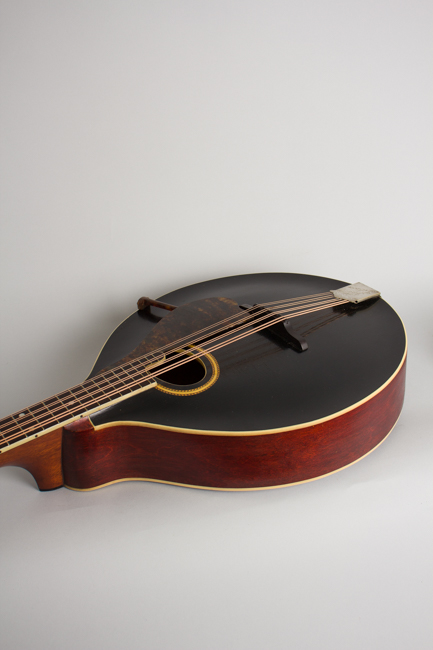Gibson K-2 Carved Top Mandocello (1913)
This item has been sold.
Item # 10513
Prices subject to change without notice.
Gibson K-2 Model Carved Top Mandocello (1913), made in Kalamazoo, Michigan, serial # 19439, black top, natural back and sides finish, birch back and sides, spruce top; mahogany neck with ebony fingerboard, original black hard shell case.
The Gibson Mandocello remains one of the great under-appreciated instruments of the early 20th century. Originally designed for the 1910s mandolin orchestra craze, these imposing beasts never found a home in other styles of music despite being often wonderful and always unique-sounding instruments. Double-strung and tuned in fifths starting with the C below the low E on the guitar, the mandocello has an imposing tone and deep resonance unlike any other fretted instrument. OK, we're starting to sound like an old Gibson catalog here, but we really like these and are always happy to get one in stock!
This beautiful K-2 Mandocello was made in early 1913, the decade when Gibson was defining the market for these instruments. In the 1910s Gibsons were only available from licensed teacher-agents, and were often purchased on a time payment plan along with the lessons. As part of the deal the students would often get to play in the teacher's fretted orchestra, and the low-tuned mandocello was crucial to achieving a full sound in these ensembles. Far fewer were sold compared to mandolins, however, and the Gibson mandocellos from any era are a comparative rarity.
This instrument is a K-2, the midline model of three mandocello styles Gibson offered. It was fairly expensive when new, priced with the red-plush lined case this one still retains at $62.50. This package cost was around $15.00 more than the plainer K-1 in 1913, which would have bought a pretty nice mandolin by itself from the likes of Sears. The two models are structurally the same with the K-2 simply offering some extra "geegaw" (decoration)! The headstock face carries an inlaid Fleur-de-Lys in pearl and abalone while the tuners are tipped with the beautiful inlaid Handel buttons. The sound hole ring is embellished with extra half-herringbone rings and the top has an ebony finish. Features the same on both models include a bound top, back, and fingerboard, raided pickguard and "crown" engraved tailpiece cover.
Often misunderstood and under-appreciated, the mandocello with its 8 strings and "C" orchestral tuning has a totally unique sound and can be used for a wide range of playing styles, some yet to be explored! "Perhaps the most satisfying instrument, of all the fretted instruments, is the Mandocello" wrote Lewis A. Williams in the 1912 Gibson catalog "In tonal broadness, richness and carrying power it is peculiarly distinctive and phenomenally gratifying". We couldn't have said it better ourselves! We will just add that this particular K-2 has some old repairs but even so is one of the better sounding ones we have heard, and comes closer to living up to Mr. Williams grandiose claims than many.
Overall length is 38 in. (96.5 cm.), 14 1/16 in. (35.7 cm.) width, and 3 1/4 in. (8.3 cm.) in depth, measured at side of rim. Scale length is 25 in. (635 mm.). Width of nut is 1 5/8 in. (41 mm.).
This is a fine playing and sounding nearly 110 year old K-2, showing some wear and repair but in excellent structural condition. The very thin original finish appears intact and unaltered; no overfinishing is detectable. The varnish shows micro-checking and a the typical collection of dings, dents and scratches overall most notable pick scratches to the upper top and some wear to the wood on the back of the neck. The carved ebony bridge is original, the removable saddle pieces have been shaved down to seamlessly lower the action.
There is one quite noticeable repaired crack to the top just below the fingerboard, running from the forward edge to the soundhole rim. This is solidly sealed but a bit ugly, with some distortion to the celluloid at either end. It is well closed up with some fill, and does not present an ongoing structural issue. There are several sealed thin grain cracks to the rim between the heel and the area around the pickguard clamp, sealed cleanly with no overfinish so still visible. The instrument shows no other visible cracks or major repairs.
All the hardware is original and complete, including the inlaid-button Handel tuners, tailpiece and cover and the often missing pickguard and bracket clamp. The three-piece laminated mahogany neck is still quite straight and original thin wire frets are in fine shape. This is an excellent playing and sounding mandocello with a powerful and ringing sound with plenty of volume and depth.
This mandocello is housed in the original deluxe hardshell case introduced around this time, which has some wear but is fully functional. This model with the red plush lining was the top of the line and added $13.50 to the 1912 price! This is not the most perfect K-2 we have had but an excellent example to actually play. Overall Very Good + Condition.
The Gibson Mandocello remains one of the great under-appreciated instruments of the early 20th century. Originally designed for the 1910s mandolin orchestra craze, these imposing beasts never found a home in other styles of music despite being often wonderful and always unique-sounding instruments. Double-strung and tuned in fifths starting with the C below the low E on the guitar, the mandocello has an imposing tone and deep resonance unlike any other fretted instrument. OK, we're starting to sound like an old Gibson catalog here, but we really like these and are always happy to get one in stock!
This beautiful K-2 Mandocello was made in early 1913, the decade when Gibson was defining the market for these instruments. In the 1910s Gibsons were only available from licensed teacher-agents, and were often purchased on a time payment plan along with the lessons. As part of the deal the students would often get to play in the teacher's fretted orchestra, and the low-tuned mandocello was crucial to achieving a full sound in these ensembles. Far fewer were sold compared to mandolins, however, and the Gibson mandocellos from any era are a comparative rarity.
This instrument is a K-2, the midline model of three mandocello styles Gibson offered. It was fairly expensive when new, priced with the red-plush lined case this one still retains at $62.50. This package cost was around $15.00 more than the plainer K-1 in 1913, which would have bought a pretty nice mandolin by itself from the likes of Sears. The two models are structurally the same with the K-2 simply offering some extra "geegaw" (decoration)! The headstock face carries an inlaid Fleur-de-Lys in pearl and abalone while the tuners are tipped with the beautiful inlaid Handel buttons. The sound hole ring is embellished with extra half-herringbone rings and the top has an ebony finish. Features the same on both models include a bound top, back, and fingerboard, raided pickguard and "crown" engraved tailpiece cover.
Often misunderstood and under-appreciated, the mandocello with its 8 strings and "C" orchestral tuning has a totally unique sound and can be used for a wide range of playing styles, some yet to be explored! "Perhaps the most satisfying instrument, of all the fretted instruments, is the Mandocello" wrote Lewis A. Williams in the 1912 Gibson catalog "In tonal broadness, richness and carrying power it is peculiarly distinctive and phenomenally gratifying". We couldn't have said it better ourselves! We will just add that this particular K-2 has some old repairs but even so is one of the better sounding ones we have heard, and comes closer to living up to Mr. Williams grandiose claims than many.
Overall length is 38 in. (96.5 cm.), 14 1/16 in. (35.7 cm.) width, and 3 1/4 in. (8.3 cm.) in depth, measured at side of rim. Scale length is 25 in. (635 mm.). Width of nut is 1 5/8 in. (41 mm.).
This is a fine playing and sounding nearly 110 year old K-2, showing some wear and repair but in excellent structural condition. The very thin original finish appears intact and unaltered; no overfinishing is detectable. The varnish shows micro-checking and a the typical collection of dings, dents and scratches overall most notable pick scratches to the upper top and some wear to the wood on the back of the neck. The carved ebony bridge is original, the removable saddle pieces have been shaved down to seamlessly lower the action.
There is one quite noticeable repaired crack to the top just below the fingerboard, running from the forward edge to the soundhole rim. This is solidly sealed but a bit ugly, with some distortion to the celluloid at either end. It is well closed up with some fill, and does not present an ongoing structural issue. There are several sealed thin grain cracks to the rim between the heel and the area around the pickguard clamp, sealed cleanly with no overfinish so still visible. The instrument shows no other visible cracks or major repairs.
All the hardware is original and complete, including the inlaid-button Handel tuners, tailpiece and cover and the often missing pickguard and bracket clamp. The three-piece laminated mahogany neck is still quite straight and original thin wire frets are in fine shape. This is an excellent playing and sounding mandocello with a powerful and ringing sound with plenty of volume and depth.
This mandocello is housed in the original deluxe hardshell case introduced around this time, which has some wear but is fully functional. This model with the red plush lining was the top of the line and added $13.50 to the 1912 price! This is not the most perfect K-2 we have had but an excellent example to actually play. Overall Very Good + Condition.












